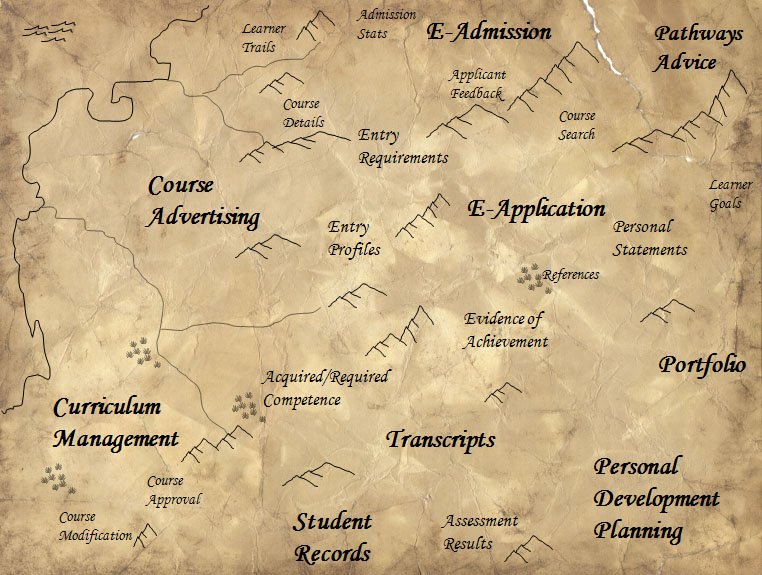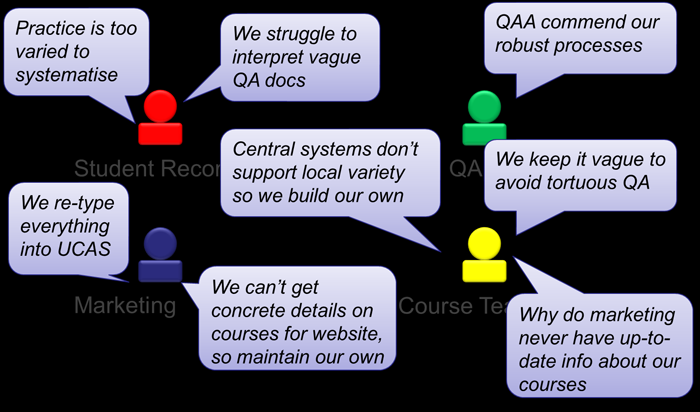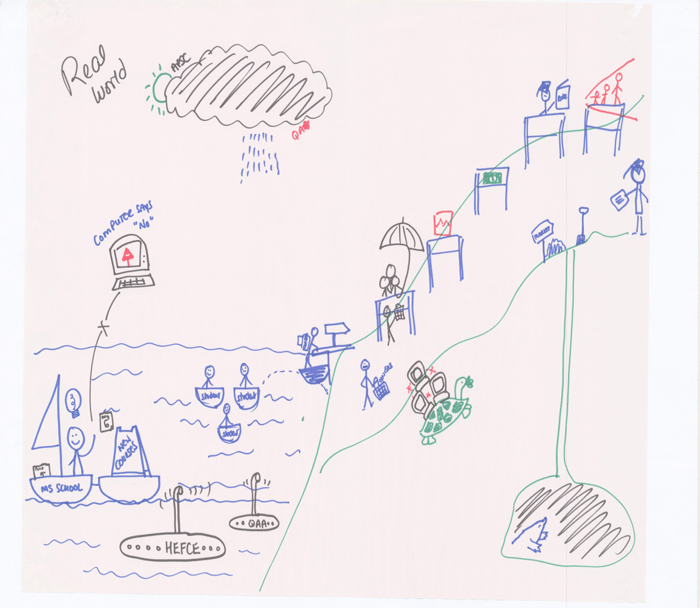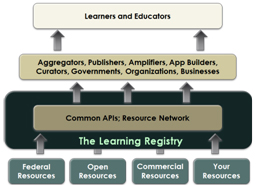In her second post on Curriculum Design Lou McGill considers how institutions connect and manage course information, and the role that XCRI can play.

This ‘middle earth’ style map produced by Professor Mark Stubbs, Managed Learning Environment Project Director at the Manchester Metropolitan University (MMU) shows the extent of information about courses that exist in further and higher education institutions. What is missing on the map, and sometimes within institutions, are the paths which connect the breadth of processes and systems that link up this data. It would certainly make for a more complex picture but this is actually what many of the Institutional approaches to Curriculum Design projects are doing through business process mapping and through their baselining and early stakeholder engagement activities. The previous post introduced some of the approaches adopted by projects to map their processes. This post offers a bit more detail of the ways they managed their information and made sure that systems share and utilise this effectively.
Course information comprises a range of data from several fundamental processes including course creation, approval, validation, documentation, QA, resource management (timetabling, resource allocation), modification and review. It seems rather obvious to say that the management of this information presents many challenges but feedback from the projects has seen common use of terminology such as ‘grappling’ and ‘wrestling’ to describe their efforts to prevent duplication and disconnected silos of data. Projects also highlighted a need for different views and pathways into course information for different stakeholders. However, course information does not exist in isolation and projects really benefitted from taking a broad view of the whole institutional landscape and thinking about how the different processes and data across other functions connect. This rich picture emerging through conversations with several projects nicely highlights the need for joined-up thinking across organizational boundaries between Student Records, Quality Assurance, Marketing and Course Teams.

Course approval, as an example, is a key activity in curriculum design and during baselining activities several projects identified challenges with existing processes as they involved formal (with a strong emphasis on QA) and well established paper-based methods. The format of this activity shaped the kinds of information collected and resulted in the need for augmentation and modification at later stages when inputting the data into different systems. Projects highlighted that many staff responded to the process as a ‘form-filling’ exercise rather than an opportunity to think about and re-consider their practice. At a practical level course related documents (such as handbooks, online module descriptions) were usually developed locally and quite separately to the course approval process. At a more strategic level, course-related information to support decision making and planning was often poorly collated and managed. How institutions utilise diverse course feedback information such as external examiners reports, evaluation data and broad market research is often subject to localised departmental approaches.
The UG-Flex project team carried out a business process review for the University of Greenwich’s existing Programme Approval and Review process in order to identify stakeholders, issues and inform system requirements. The resulting documents are now informing ongoing system review at Greenwich. Other course process maps from other projects are included in the previous post and more will eventually be available on JISC Design Studio.
Linking student and course information
Student data, which includes information about enrolment, admissions, registration, progression, assessment, records and e-portfolios, links to course information at several points and project activities have also included work in this area. A significant issue to emerge during the review process was that many existing institutional systems reflect the more traditional standard academic year course patterns. Departments which had adopted more flexible teaching approaches and models to respond to changing learner demands were frustrated by centralised systems that did not fit their needs and were using workarounds to fit their students in or developing parallel local systems. UG-Flex project stakeholders described cases where some students on short courses who had actually finished their course before gaining access to the VLE, which highlighted the need to organise their information differently to ensure timely access for different student cohorts.
Claire Eustance, Project Manager at UG-Flex emphasises the need to establish and maintain trust when undertaking business process mapping to ensure that initial talks with staff are followed-up, with them being shown the outcomes and solutions to problems and keeping them involved throughout the process.
‘When we first started talking to our stakeholders their perception tended to be that problems lay in the systems and what they could, or couldn’t do. Eventually though more people are beginning to understand that the systems merely reflect existing institutional mechanisms which have either simply evolved over a period of years or have been based on the needs of ‘mainstream’ students. I can’t stress enough how significant this has been. Now at Greenwich, at the highest level, there are moves to ensure that our organisational mechanisms and processes reflect the needs of all of our students. Once we have these in place then the systems will be redesigned around them.’
UG-Flex’s efforts to reveal and map Greenwich’s institutional processes and how systems support these have helped strategic and operational managers recognise and articulate the need for change. UG-Flex aspires to see this approach to business process review and mapping embedded into mainstream strategic planning at Greenwich, anticipating long term benefits as systems and processes develop through cycles of change and review. Whilst this can appear to be about efficiencies such as reducing the administrative burden, duplication and clerical error, the crux is the real value that comes from being able to enhance the experience for all students.
Where VLEs link into wider systems
One of the places that most learners connect with institutional systems is through the VLE, and whilst they may not be interested in the underlying processes and systems, their learning experience can be significantly affected by them. VLEs are just one of the systems that benefit from well managed course and student information.
The PREDICT project at City University have been looking at how course information links to student data with a particular emphasis on the admissions process and through linking information about student module choices to the VLE. The new student registration system at City has led to improved quality of information and significant reduction in administrative time (from 3 hours to 10 minutes) with about 90% of students registering online before their courses started. The vision is that on day one a student at City University will log into the VLE and see their own space with appropriate course information, discussion areas and content, and ultimately assessment and grading information. This will be achieved through the use of middleware to establish automatic links between the VLE , the admissions system, course information systems, the student record system, the library, finance and identify management functions to facilitate the sharing of data.
Quite apart from the cost efficiencies (saving £20K per year on printing postage and data entry) time is freed for staff to do other activities and the student experience at the very beginning of their relationship with the University is significantly enhanced. The way that information is now being made available across systems immediately is a vast improvement on the traditional data-dump scheduled transfer that those of us who have been around for a while are very familiar.
With an imperative to reduce duplication and the drive to enhance the student experience it is also possible to personalise the student view of their modules through the creation of rules which link content within the VLE. So, for example, a student registered on one course may automatically have relevant content from a different course or module revealed. There are also plans to incorporate module information so that students can select elective modules online, requiring links with timetabling and resource planning information. This can be quite a drawn out process as their selections may depend on results due in several months time – hence a need to incorporate attainment data. This currently necessitates some backward data exchange as marks entered into the VLE need to be seen by the student records system.
Like other projects the activities of the PREDICT team have resulted in revised documentation and data collection mechanisms. One example is their module and programme revision documents which are available on the project website. In the longer term the institution is also considering linking the VLE to the student application and enquiry processes and the potential of using university OERs to feed into broader marketing processes. Future plans also include addressing staff and research data. The pragmatic incremental approach taken by City has some merit making sure they achieved some quick wins and using those to push forward more challenging tasks.
The student experience can be greatly enhanced by quite pragmatic approaches to incorporating information into VLEs and making them transparent to learners. Some of the projects in the sister programme Transforming Curriculum Delivery Through Technology saw significant enhancement through these kinds of approaches, such as course enrolment and payment, timetabling, attendance data and assignment handling. At the heart of these achievements is the need to create core sets of data that can be exposed in number of places… Perhaps the most significant example of this in relation to course information is XCRI.
XCRI (Exchanging Course Related Information)
The value of XCRI as a standard to facilitate exchange of course related information is fairly obvious, but an imperative for implementing it on a wide scale in institutions has been lacking. However the HEFCE requirements for institutions to provide KIS (Key Information Sets) for all courses from September 2012 and to feed into the HEAR (Higher Education Achievement Report) recording student achievement have both provided strong drivers to encourage the implementation of XCRI.
Mark Stubbs, mentioned earlier, has been involved with both the SRC Project (Supporting Responsive Curricula) which was featured in the earlier blog post and with the development of XCRI said “Although being able to make prospectus information available on course comparison websites without retyping will doubtless become a plus, the real value of XCRI lies in re-thinking business processes used to manage course-related information so that definitive data are available freely for re-use: for transcripts, for course approval, to provide context for VLE activities, to support personal development and for business intelligence-driven continuous improvement”
I plan to talk in more detail about XCRI in a future post…
It’s hard to capture the range of activities of a whole programme in a few blog posts but some key issues to emerge from talking to projects and reading their outputs so far are:
- need for creation of core data sets that can be exposed in a variety of places
- technical systems are sometimes perceived as the root of problems but simply reflect traditional and sometimes outmoded practice
- integrated technical solutions can have significant impact on reducing inefficiencies and duplication if based on institution-wide dialogue and examination of processes, and through streamlining systems to share data more effectively
- need for changes to documentation to facilitate better data collection – and best done after business process modelling has been undertaken
- value of integrating business process review into ongoing core practice
- stakeholder engagement and ongoing involvement
- utilising modelling methods that suit the organisation
- curriculum design and delivery can become embedded into core institution planning by making sure that people involved in making key decisions start with the learning and teaching requirements
- informed curriculum planning can result from streamlined systems and people that understand , engage with, view and contribute to curriculum development processes in more meaningful ways
Perhaps it is better said by the SRC Project from MMU when talking about the development of their central academic database…
‘The change to an authoritative single source of courses information from pre-validation through advertising, enrolment, teaching and learning, and to production of HEAR records and even alumni support is a powerful one. It involves breaking down self-standing silos of information and addressing information technology and process issues across the whole institution. It results in a deeper knowledge and understanding of curricula by staff in the institution, and potentially by partners, by students and other learners, by employers and employees. This knowledge and understanding can be used to develop new curriculum elements, both pro-active and reactive to demands from inside and outside the institution, from learners in general and from employers in particular. At the heart of this is a customer-centric view that sees the organisation’s processes from a student viewpoint, the student customer journey being an end-to-end lifecycle that cuts across institutional functional silos.’
Excerpt from SRC case study.
|
A shorter two year sister programme ran in parallel to the Institutional approaches to Curriculum Design programme which focussed on curriculum delivery – the space where students engage with the curriculum. Both programmes naturally involved some overlap with curriculum design and delivery having close synergies. The Transforming Curriculum Delivery Through Technology programme has now completed and outcomes (lessons learned) and outputs (case studies, guidelines, etc.) are incorporated into the JISC Design Studio. Both programmes are feeding into this resource which was created during the programmes to provide both a resource for projects and ultimately a source for the wider community. http://jiscdesignstudio.pbworks.com/w/page/40379712/Transforming-Curriculum-Delivery-through-Technology http://jiscdesignstudio.pbworks.com/w/page/40489793/Institutional-Approaches-to-Curriculum-Design |
About Lou
Lou McGill is currently working independently and has recently been involved in synthesis and evaluation activities for the HE Academy/JISC UKOER programme and the JISC Transforming Curriculum Delivery Through Technology programme. She lead the team that produced the Good Intentions report on business cases for sharing and worked on the LLiDA study (Learning Literacies in a Digital Age). She has experience of working in a range of HE institutions as a librarian, learning technologist and project manager and used to be a JISC Programme Manager on the eLearning team. In the distant past she worked for NIACE (the adult learning organisation) and in Health education for the NHS. Her interests and experience include digital literacy, information literacy, open education, distance learning, managing organisational change, and effective use of technologies to support learning. Further information on Lou’s work can be found at: http://loumcgill.co.uk




